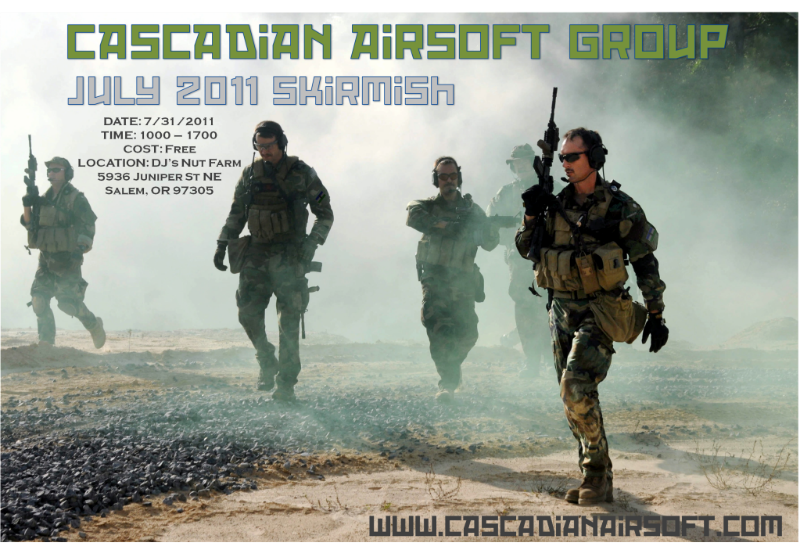Chesty_01 wrote:Do u have pictures of said nut farm? And that's not a nice way of saying gay bunny ranch right? I wanna know what I am getting into.
We ( CAG) call it the nut farm because we did not want to have it confused with "the farm"
Think sniperzden. The little pudding river runs thru the back portion of the farm and makes for a serious wet land / swamp area. Sorta like combat in Viet Nam without the poisonous snakes and Mr Charles in black jammies. We camp at the farm area / hazelnut trees, not so much play in the actual farm area. The neighbor has recently allowed us to use his property too. This added "heartbreak ridge", that is the area where this scenario will occur. No pics, don't want to spoil the surprise.
Oh and bring the flight gear, it would add a nice touch.
We have an honest to God spec ops type affiliated with CAG: this is his input;
Re: July training at the nut farm
In SAR operations, the pilot lies low in the day and moves, if he must, at night. The pilot has a PRC 112 and IR rescue beacon. The PRC 112 is a radio beacon that generates an encrypted signal on 406 Mhz for a satellite to receive and pin point the downed pilot. The radio also transmits on various encrypted voice frequencies for final talk through in the air-to-ground approach and rescue mode. Rescue under NATO doctrine is typically by helicopter, although there are other methods. There is also an escape and evasion plan briefed to fllight crew and SOF personnel operating/downed behind lines. This is a backup for self extraction. But we would need to create an "underground" of people in an area willing to help in what essentially amounts to a resistance movement and practically speaking, becomes a big game of chase.
The pilot only has a pistol with a couple of magazines.
A time element might enter into play for victory conditions. So might points be had if a pilot makes it to certain points.
How do we simulate some of this?
Communication with pilot: PRC-112 or NATO SARBE 6-402: We cannot legally use a transponder device without brining in a real helicopter and a pissed off police officer to arrest us for misuse. But we can still use another radio system. HAM or FRS. Either could be monitored by OPFOR (and should be). The pilot talks to the HQ and the rescue party. This adds realism to the hunt. The HAM radios have a scanning function that should be able to search in the FRS bands. If the pilot has a HAM license, he can use his HAM radio. He would be assigned three frequencies across a broad radio spectrum and a code word to speak or a date or time change to switch frequencies. Multiple band HAM would be the way to go. Some of us have three band HAM radios. It would make the scanning/detecting function much more difficult, but still possible. FRS is only limited to 16 frequencies. After initial contact is made by HQ, transmission by the pilot is typically undertaken with short bursts only when he has the rescue party/aircraft in audible or visual range.
Map reading can be utilized.
Rescue force: Perhaps the rescue force gets a free pass to begin its operations at a start point to simulate the helicopter insertion. As the rescue unit is only large enough to fit on the helicopter and is typically the size of a chopper crew with M-4's and maybe a few SAW's or mini-guns, it is numercially inferior to any OPFOR ground force arrayed against it. Or maybe the rescue force gets a few minutes head start on the ground before OPFOR is allowed to deploy. Something can be worked out.
Signalling: The pilot and rescue party might have IR signalling devices. Or laser signalling devices. The pilot's IR signal is detected by an NVG or another, even simpler, technology. A laser could be employed by the rescue party. How do we simulate this? I have an NVG and an MS 2000. I also have a laser rescue flare. The NVG is first generation and does not work all that well, but it would easily see the MS 2000 operating on IR strobe at night as a bright flash. So the pilot gets the strobe light and the rescue party gets the NVG and the laser beacon. The pilot might make radio contact and turn on an IR strobe signal to guide the rescue party to him. The rescue party, if it so desires to confirm its friendly presence and its approach to the pilot, can take a chance and shine its focused rescue laser. This is like a challenge and password. If the wrong color rescue laser is used or not used at all, then the pilot runs for it. The rescue party would shine the laser and the pilot could confirm the color and guide the party to final link up. I think you get the idea.
OPFOR patrolling for a downed pilot: OPFR searches using the anvil and hammer. A map is consulted to locate likely places a downed pilot might be hiding within an AO. A blocking force is placed in position at the end of or within a key portion of a search area. Small hammer patrols are dispatched to locate and drive the prey into the trap. Or boxes in a target area are gridded. Multiple coordinated patrols operate within the boxed zones to clear them before moving into the next set of search boxes. The idea is simple: You put a few squads on line along a front too broad for a lone pilot to outrun without being spotted. This is the same rough technique used to hunt down insurgents. Multiple adjacent units search a box from end-to-end. The unit doing the patrol may not realize their contribution because they may not make contact, but the higher echelon controlling the operation sees it unfolding across a broader spectrum. Again, these are just ideas to add some sport and to teach you a thing or two about these sorts of things.
I am hoping to incorporate as much of this as possible into our little op.













 im super eager to learn anything i can from you guys.
im super eager to learn anything i can from you guys.